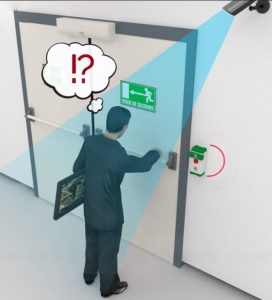Securing people and ensuring the safety of assets
The challenge of managing emergency exits is to guarantee both the safety of people and the security of assets in an establishment. Emergency exit doors must be accessible and open in the event of an evacuation. However, they cannot remain completely “free” in order to protect the site against intruders.

For example, in concert halls or exhibition centres, visitors who have paid their admission fee are not able to let accomplices in free of charge via an emergency exit without triggering an alarm.
In public buildings such as ministries, there is a real risk that emergency exits will be invaded during a demonstration. The installation of a UGCIS (Centralised Emergency Exit Management Unit) located at the security control centre, with information relayed to the safety control centre, makes it possible to provide real-time information on the state of the door and to over-lock the exits to prevent demonstrators from entering the building.
This locking system has 3 modes: locked, unlocked and over-locked. Customers can switch to “no-public” mode (night mode) to make their building secure and prevent break-ins and burglaries. This mode is the responsibility of the head of the establishment.
Similarly, it is important to prevent emergency exit doors from being blocked in the open position. For sensitive sites, it is important that security and safety systems communicate with each other. The UGCIS (Centralised Emergency Exit Management Unit) makes it possible to monitor emergency exit doors in real time and to report information about people passing through them. The system can be connected, via a communication gateway, to the access control or BMS (Building Management System) to transmit the status of the doors.


